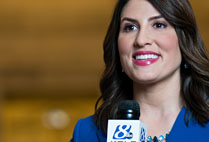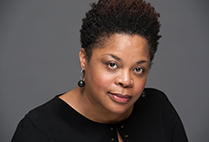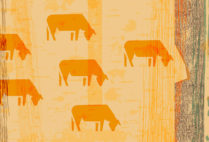Growing Up in Detroit—and Madrid
When Williams speaks of getting people to rethink assumptions about what it takes to succeed in higher education, she points to her own story.
“Who I am is the result of some genetics and a lot of loving and nurturing and access to privilege, which was the luck of the draw,” she says.
She is talking in her eighth floor office at One Silber Way, with its sweeping views of the Charles River Campus. Had she not been raised in a family with resources, she says, “the likelihood that I would be sitting where I am now, in 2018, in Boston, Mass., is almost nil.”
Her parents adopted her as a baby. Her father had come to Detroit in the Great Migration, the mass movement of blacks from the South to the North during the middle of the 20th century. He was a jazz pianist who worked at the Ford foundry. He met Williams’ mother, a school psychologist, when she walked into the club where he was playing piano.
“She was almost 30 years his junior,” Williams says. “He was black—and a dark-skinned black man. And they met in the ’60s. I remember asking her one day, ‘What were you thinking when you married Dad?’”
Her mother’s answer is found in Williams’ poem “The Masked Woman.”
…I just loved him.
Race didn’t enter the equation, only age.
She weighed the 30-year-fault & concluded
She loved him enough to lose him.
Her parents’ marriage helped prepare her for her work in diversity, says Williams.
“Nobody thought my parents should get married in 1967,” says Williams. “My parents decided to love each other quite outside the norms of the society they were living in. The lesson I extracted from that is that love is the most powerful of endeavors, and it can supersede everything.”
She was raised in Lafayette Park, an integrated, middle-class Detroit neighborhood. Her mother sent her to a private elementary school—and to classes in etiquette, skating, and dance. The two of them went each week to the library, where Williams started with Judy Blume and Nancy Drew and moved on to the poets Sonia Sanchez, Nikki Giovanni, and Lucille Clifton, and to James Baldwin.
When she was eight, her mother took her to Madrid to live for two and a half years to learn Spanish. She was 11 when her father died.
At Detroit’s Cass Technical High School, Williams wrote her first poem. Her English teacher, Arthuree Leach, read it aloud. “You know how kids are,” Williams says. “You really don’t have to give them more than one little pat on the head and they are all in.”
Her drama teacher, Marilyn McCormick, sparked Williams’ dreams of becoming an actress. She went to Wayne State University on an acting scholarship, transferred to Howard University, worked at a bookstore, dropped out, moved to New York City, struggled as an actress, worked double shifts at a Fuddruckers—and blossomed as a poet.
In 1995, her performance poem, “In Search of Aunt Jemima,” was the only one awarded a perfect score in a national slam competition and since has been widely performed and published. Williams has authored four collections of poetry to national acclaim, including the 2009 Naomi Long Madgett Poetry Award.
McCormick and Williams have remained close. “If you want to know Crystal Williams,” says McCormick, “read ‘In Search of Aunt Jemima.’”
…I’ve read more fiction, non-fiction, biographies, poetry,
magazines, essays, and bullshit than imaginable, possible,
or even practical. I am beyond well read, am somewhat of a bibliophile. Still,
I’m gawked at by white girls on subways who want to know why
and how I’m reading T. S. Eliot….
I am not your convenient Black friend….
I am not your Aunt Jemima.
Williams earned a BA in English from New York University, went on to Cornell for an MFA, and then to Reed College, where she was an assistant professor of English and joined other faculty in pushing Reed to become more inclusive. Reed’s response was to make her the first dean for institutional diversity.
Poet Elizabeth Alexander (GRS’87), who heads the Andrew W. Mellon Foundation, says Williams is not only “a brilliant artist,” but also “a visionary administrator.” Alexander chose Williams and nine other poets to write verse for the 2015 exhibition of Jacob Lawrence’s paintings of the Great Migration at the Museum of Modern Art (MoMA) in New York City.
At MoMA, Leah Dickerman organized the Jacob Lawrence show and came to know Williams through her involvement with it. “She maintains this sort of dual practice: as an administrator, in which she’s thinking about structures of inequity, and as someone who uses their poetry to ask questions about the world,” says Dickerman, who was a curator in the museum’s painting and sculpture department and has since become MoMA’s director of editorial and content strategy. “Great art asks important questions about the world. The idea of being an administrator is about finding solutions and trying to make our institutions stronger, more equitable, and more inclusive.”
At Bates, in addition to her leadership role, Williams was a senior advisor to the president, Clayton Spencer. “Crystal understands that she’s about culture change and that if you’re going to be effective, you need to bring others along with you. It’s really important to establish forums in which you can understand where people are coming from and then figure out how to meet them where they are,” says Spencer.
“She’s a big thinker. She has great ideas, she motivates people, and she makes the work compelling.”
Williams was instrumental in designing and securing a $1 million Mellon Foundation grant focused on diversifying the faculty. She also played a key role in enabling Bates to join the Creating Connections Consortium, a group of liberal arts colleges and research universities, which helped faculty broaden their networks and expand their pool of potential candidates from underrepresented groups.
“Her strategies were really ingenious,” says Kathryn Low, a Bates professor of psychology and interim dean of the faculty. “She’d say, ‘You’re not familiar with the scholars in your field? Let’s bring some of them in and learn what’s going on. It will inform your search, diversify your pool.’”

Changing institutions takes time. “It has to be done step by step,” says Williams, “with vision, strategy, creativity, and perseverance.”
Photo by Brian Fitzgerald
Before long, Williams says, “What I heard from multiple faculty was, ‘Omigod, I didn’t realize there were candidates of this caliber in the pool.’”
At BU, Williams has begun meeting with groups of people from academic and other institutions in the city in an effort to build stronger ties between the University and Boston’s communities of color.
In the first week of February, she hosts a networking evening for Women of Color in the Academy, a Boston-based group started at Northeastern University. Some 170 women from colleges across the region circulate in the Metcalf Ballroom, talking over wine and cheese.
Yvette Cozier (SPH’94,’04), a BU School of Public Health assistant professor of epidemiology and associate dean for diversity and inclusion, is in the crowd. Cozier was a member of the search committee for the new associate provost for diversity position. “Her personality, her words, her spirit, her ideas, her experience—it was everything combined,” says Cozier. “There’s nothing easy about diversity. In this job, you’re going to have to stand up to a lot of people. She knew exactly who she was and where she was coming from.”
At the podium, Williams leads a rousing call and response:
“Northeastern’s in the House!”
A cheer goes up.
“MIT! MIT’s in the house!” Another cheer.
“We got Harvard—Harvard’s in the house!”
She calls out Emerson, Brandeis, Wellesley, Lesley, Tufts…
“Can I say BU?”
A shout goes up: “BU!”
Williams looks around the ballroom and says, “Look how beautiful you all are.”
Later, at a lunch she is hosting for faculty and staff of color at the Questrom School of Business, Roscoe Giles stands to welcome her. Giles, a College of Engineering professor of electrical and computer engineering, who arrived from MIT in 1985, was a member of the provost’s 2015 Committee on Faculty Diversity and Inclusion, which recommended, among other things, creating the position Williams holds.
“I’ve been waiting a long time for you to appear and for these conversations to become more institutionalized,” Giles says. He remembers when barely more than a dozen faculty on the Charles River Campus looked like him.
“This is such an improvement,” Giles says, looking around a room filled with more than 100 faculty and staff.
Williams tells her audience why she has come to BU. She tells them that retention is a priority. “You can recruit talent and if there is a chilly environment, it’s hard to get people to stay, and then they scoot.”
She tells them that diversity is one of the pillars of the University’s new strategic plan and that part of her role is helping leadership think about how to put that into practice in a meaningful way. She repeats what has become her mantra: she needs everyone’s help—and their patience. Changing institutions takes time. “It has to be done step by step—with vision, strategy, creativity, and perseverance.”





















































Yes , I believe in true diversity. How will you address the inclusion of Women,Asian ,Latinos,Polish,Italian ,Irish Afghan,Syrian,Egyptian,Palistinian and Isralies Will you mentor these minorities also. We have never had Asian,Moslem or Jewish president. How will help these groups in the future.
Robert Baskies CLA 1974
Impressive academic credentials and the soul of a poet!